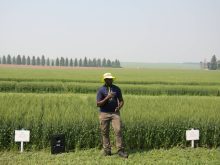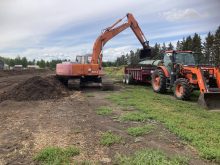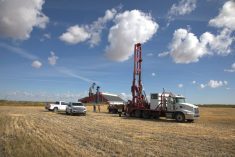It was a dramatic claim — if Canadian farmers reduce their fertilizer use by the federal government’s proposed 30 per cent, they could lose $48 billion by 2030.
It came last month in a release from Fertilizer Canada, which said that, that would be the loss if Canada followed the European model of cutting fertilizer use to reduce greenhouse gas.
“When the federal government announced its emission-reduction targets related to the use of fertilizer at the end of the year (2020), it didn’t provide a whole lot of detail as to how that was going to be envisioned, or how we were going to achieve that,” said Fertilizer Canada’s president and CEO Karen Proud.
“Our concern was that if you reduce the amount of fertilizer, it could have a significant impact on productivity, and you’re putting a cap on the market.”
In response, Fertilizer Canada commissioned a study by Meyers Norris Penny. Its conclusion of the $48-billion loss wasn’t pretty, but farmers shouldn’t panic yet.

“The Canadian government hasn’t said definitively that it was going to adopt a European model, but this is kind of our worst-case scenario and we wanted to see what it would mean,” Proud said. “We aren’t suggesting that this was going to be the approach. Somebody had to do the impact analysis to start the discussions on what makes the most sense to actually achieve when it comes to emissions in the agricultural sector when it comes to fertilizer.
“If anything, what this study says is that putting caps on fertilizer rates is going to be a problem. Let’s look at what the solutions could be; let’s look at a program that makes a lot more sense, and balances the economic, social and environmental needs.”
Fertilizer Canada is promoting the 4R approach, which was developed more than a decade ago.
The 4R approach means right rate, right timing, right source and right placement.

“You really want to use those fertilizer nutrients effectively,” said Jeff Schoenau, a professor in the soil science department at the University of Saskatchewan. He said that 4R is a prudent and potentially effective way of limiting emissions of greenhouse gases such as nitrous oxide.
“That’s a benefit for grower economics and the environment. I think there’s an impetus to get 4R information and economics out there.”
Made-in-Canada policy
Proud said Fertilizer Canada is encouraging the government to embrace 4R.
“Providing farmers with incentives and tools to be adopting these 4R practices can go a long way to addressing emissions reductions. It’s not the only tool in the tool box, but it’s one of the important ones. There are other things that can be used as well, like no till and cover crops and things like that.
“The main thing we are asking of the federal government is to sit down with all the stakeholders to work out a practical and pragmatic approach. We are 100 per cent behind efforts to reduce emissions. There is no question about that. It’s now about how we’re going to go about it and make sure it’s something that farmers can implement without those detrimental effects.”
Proud suggested that it might be a topic of discussion at the next provincial, territorial and federal agricultural ministers’ meeting.
Grain Growers of Canada chair Andre Harpe echoed Fertilizer Canada’s position.

“Fertilizer Canada is basically recommending a made-in-Canada policy,” said the Valhalla Centre farmer. The Grain Growers would like a solution that works for farming in Canada.
He said many producers have already started to curb emissions by adopting zero till to sequester carbon.
“What we recommend is using fertilizer at the right amount for the right place, and starting to look at options such as variable rate, so you’re putting the right amount of fertilizer where it needs to go,” Harpe said.
He says some farmers need to learn more about 4R.
“As farmers, we are always looking at ways to save money. We look at it without putting a name to it. 4R is just putting a title to what I think farmers are gradually going to do anyway.”
Read Also

Moo translator and methane measures: There’s an app for that
Dalhousie University researchers use artificial intelligence to create new dairy farm apps that analyze cattle sounds and measure methane.
The Grain Growers and other groups would also appreciate clarity from the federal government.
“When the government talks about a 30 per cent reduction in fertilizer, we do not actually know what that means. I think we have to know what that means.”
Harpe said farmers need to work with government to develop the made-in-Canada solution. “This government is focused on climate change. It’s one of those things, like it or not, we have to work with. If we don’t like the solutions it is proposing, we have to come up with our own solutions.”
There are huge differences between what happens in Europe and what happens here. We don’t need a model that was made somewhere else,” he said.
















